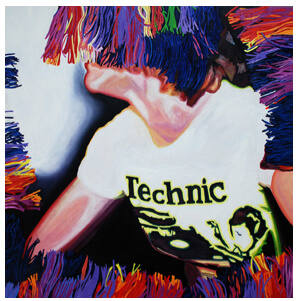Julie Orr: Art Socially Sculpted


What inspired your newest project, including “Keep Telling Yourself That”, “Buried”, and “Electric Plastic”?
We consume plastic and are consumed by it. I am interested in our obsession with the material which is a part of almost every person’s life on the planet yet very toxic and damaging. Plastic cosmetic and food containers, particularly, are bright, alluring forms but made of petroleum and other harmful ingredients. These chemically toxic containers, then contain chemically toxic substances like detergent, shampoo, pesticide induced food-the list goes on. I see plastic as an indication for our ignorance as well as our participation in broken, wasteful systems.

How do you feel about plastics and your level of consumption?
I feel that as humans we are all consumptive creatures so having no impact is nearly impossible but reducing it A LOT, is absolutely feasible and potentially life-saving. I refuse bottled water, recycle, drive a hybrid, bring re-usable bags to the store and reusable cups to the coffee shop. I also use all-natural cosmetics: shampoo, deodorant, soap, toothpaste, makeup, etc. (which I get mostly at Whole Foods). In fact, some of my interest regarding the issue of toxic materials and substances developed after I found myself allergic to synthetic ingredients and chemicals found in everyday products years ago. They irritate my skin greatly.
A lot of our power in the outcome of our world lies in what we buy. Sometimes it is easier for us not to think about that responsibility though and blame outside sources like the government or corporations. I’m not perfect by any means myself though. My hybrid car still uses energy and natural cosmetics are contained in non-biodegradable packaging, for example. My feeling is though, reduce waste and support the companies who are the most environmentally friendly, and our investment in them will spur more research, better technology, and push other companies in an environmentally sound direction.

What role does photographing yourself with props like plastic bottles and garbage play in your overall process? What self portraiture inspires you?
Oftentimes, there is an inner energy or sentiment I want to express in my work. I can most accurately portray that sentiment if I am the actor. Also, I am my most accessible subject. The great Cindy Sherman, who depicts a lot provocative public figures, has been an inspiration. Tracey Emin and Pipilotti Rist are influences in my work as well. All of these women artists deal with the idea of “guilty pleasure” and as my work does too. In my photographs, I exploit myself, aiming to look like a pin-up girl buried in trash, ready for consumption. I like to play with the strangeness of something being beautiful yet inconspicuously harmful or questionable at the same time. This reality is all over consumerist cultures, both physically and emotionally.

What does garbage symbolize to you?
Garbage symbolizes detachment. We are detached from the sourcing of materials, global corporations who produce consumer products and fellow living creatures. Quoting Colin Beaven from the documentary, No Impact Man, “environmental problems on our planet have come because of the breakdown of community because without community none of us feel accountable to anybody else.” It also represents a great sentiment of disposability in our culture. There is this feeling today that whatever we consume, whether a product or a relationship, can be easily replaced. This disposable attitude is all over our culture whether it is the quick life cycle of plastic packaging, the adding and deleting of friends on Facebook, holiday shopping, even war.

Speak to the paintings that are still life and mixed media elements. How do you see those represented in the larger series? What is their function in the whole?
When I started this current series related to disposability, I painted photographic references of plastic waste as my background is painting. I realized after doing a few large paintings involving trash representation that I was really setting myself apart from the material I was aiming to speak about. In response, I decided to use incorporate the actual plastic waste as material for collage pieces. I felt uncomfortable playing with the actual trash and avoided using it as a material for quite a while. Looking back at this, I realize this to be a metaphor for our withdrawn relationship (or at least my relationship) to material waste. Now I am making larger sculptures and installations using plastic waste and lights. I love the tactility of playing with the bottles and looking at their bright colors. I feel much more connected to my work at the moment than I did previously. The 2-D pieces were part of a process in discovering my voice in this new
series about disposability. I’d like to make much larger versions of both the 2-D and 3-D pieces, emphasizing the idea of excess that proliferates.

Is this series straying from your last autobiographical series in self reflection? How has the narrative changed?
In some ways it’s a continuation of my last series that was inspired by music and performance. There is still a performative element present in my work and consistent use of bright colors. I’m drawn to the aesthetic quality of plastic bottles similar to how I’m drawn to stage lights and costumes at performance. They are overstated at times and beautiful. I still perform and exhibit myself in my work as I did before but take the idea of exploitation and gender inequality to a deeper level. I am not always comfortable jumping in a pile of trash nude but I think that makes the work in some respect more interesting because there is a strange emotional conflict that hopefully shines through in my work. My professor recently called me “the shy exhibitionist.”
Responses